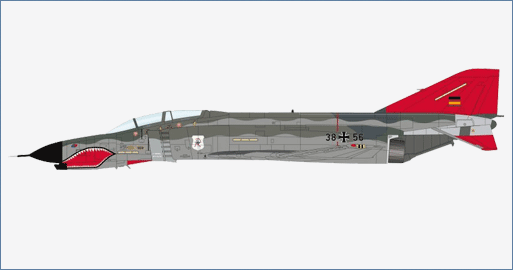Air Power Series>1:72 die-cast display model>F-4>HA19042
F-4F Phantom II "Norm 81" 38+56, JG 71 "Richthofen", GAFTIC 86, CFB Goose Bay, Canada, May 1986

General Background
The 501st TRS was the JASDF’s only Recon Squadron. It was formed in December 1961 and uses the cartoon character Woody Woodpecker as it emblem. In 1972 the JASDF decided to replace their RF86F with 14 RF-4Es and formed a detachment at Hyakuri AB to handle the new aircraft. The first F-4Es were numbered 6901- 6914 and began arriving throughout 1974 and 1975. For operation over the water 6901, 6905 and 6913 were given a special Ocean Blue scheme while converted F-4EJ and F-4EL Kai were painted in green/gray Forest scheme.
The Aircraft
JG 71 "Richthofen" converted from the F-104G to the F-4F beginning March 1974 and completed by 1975. Various paint schemes had been used by the Luftwaffe but in 1982 and onward the standard scheme was the “Norm 81”. In the 1970s and 80s NATO countries adopted low-level flying to avoid radar detection. With Europe being heavily populated it made it almost impossible to fulfill this role so to accomplish this, Germany and others were based at Goose Bay Labrador that provided 294,000 km of airspace with a population of less than 30,000.
Specifications :
| Manufacturer: | McDonnell-Douglas |
| Type: | Fighter/Ground Attack |
| Crew: | 2 |
| Dimensions | |
| Length: | 19.40 m |
| Height: | 5.01 m |
| Wingspan: | 11.70m |
| Weight | |
| Empty: | 21,950 kg. |
| Max T/O weight: | 27,300 kg |
| Powerplant : | 2 X J79-MTU-17A engines were built under license from General Electric by Motoren-und-Turbinenen-Union Munchen GmBH. |
| Performance | |
| Thrust: | 5,308 kg (8,120 kg with A/B) |
| Max speed: | Mach 2.23 @ 12,500 m |
| Initial Climb Rate: | 41,000 ft/min (210 m/s) |
| Armament: | 4 x AIM-120A AMRAMM air-to-air Missiles The F-4F originally lacked the capability of carrying nuclear weapons and it could not carry or launch certain air-to-ground missiles such as the Maverick, Shrike, or Walleye. The design that finally emerged was 3300 pounds lighter than the stock F-4E. The number 7 fuselage fuel tank was removed and all Sparrow equipment was eliminated. The AN/APQ-120 radar was simplified, with no beacon search or constant wave illuminator being provided for Sparrow or Falcon missile launches. Although no in-flight re-fuelling receptacle was initially fitted, the internal plumbing needed for midair re-fuelling was installed at the factory. |

